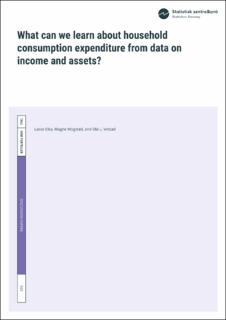| dc.contributor.author | Eika, Lasse | |
| dc.contributor.author | Mogstad, Magne | |
| dc.contributor.author | Vestad, Ola Lotherington | |
| dc.date.accessioned | 2020-04-21T12:45:30Z | |
| dc.date.available | 2020-04-21T12:45:30Z | |
| dc.date.issued | 2020-03 | |
| dc.identifier.issn | 1892-753X | |
| dc.identifier.uri | https://hdl.handle.net/11250/2651917 | |
| dc.description.abstract | A major difficulty faced by researchers who want to study the consumption and savings behavior of households is the lack of reliable panel data on household expenditures. One possibility is to use surveys that follow the same households over time, but such data are rare and they typically have small sample sizes and face significant measurement issues. An alternative approach is to use the accounting identity that total household spending is equal to income plus capital gains minus the change in wealth over the period. The goal of this paper is to examine the advantages and difficulties of using this accounting identity to construct a population panel data with information on household expenditure. To derive such measures of consumption expenditure, we combine several data sources from Norway over the period 1994–2014. This allows us to link tax records on income and wealth to other administrative data with information on financial and real estate transactions. Using this data, we derive household expenditure from the accounting identity, before assessing the sensitivity of this measure of consumption expenditure to the assumptions made and the data used. We then compare our measures of household expenditure to those reported in expenditure surveys and to the aggregates from national accounts. We also illustrate the research opportunities arising from the derived measures of consumption expenditure through two applications: the first is an examination of how relative wage movements among birth cohorts and education groups affected the distribution of household expenditure, while the second is a study of the transmission of income shocks to household consumption. | en_US |
| dc.language.iso | eng | en_US |
| dc.publisher | Statistisk sentralbyrå | en_US |
| dc.relation.ispartofseries | Discussion Paper;No. 923 | |
| dc.rights | Attribution-NonCommercial-NoDerivatives 4.0 Internasjonal | * |
| dc.rights.uri | http://creativecommons.org/licenses/by-nc-nd/4.0/deed.no | * |
| dc.subject | Administrative data | en_US |
| dc.subject | Consumption measurement | en_US |
| dc.subject | Income | en_US |
| dc.subject | Wealth | en_US |
| dc.subject | Forbruksmåling | en_US |
| dc.subject | Inntekt | en_US |
| dc.subject | Forbruksforskning | en_US |
| dc.subject | Formue | en_US |
| dc.title | What can we learn about household consumption expenditure from data on income and assets? | en_US |
| dc.type | Working paper | en_US |
| dc.subject.nsi | VDP::Samfunnsvitenskap: 200::Økonomi: 210: | en_US |
| dc.source.pagenumber | 50 | en_US |
| dc.relation.project | Norges Forskningsråd: 250516 | en_US |
| dc.relation.project | Norges Forskningsråd: 227020 | en_US |

